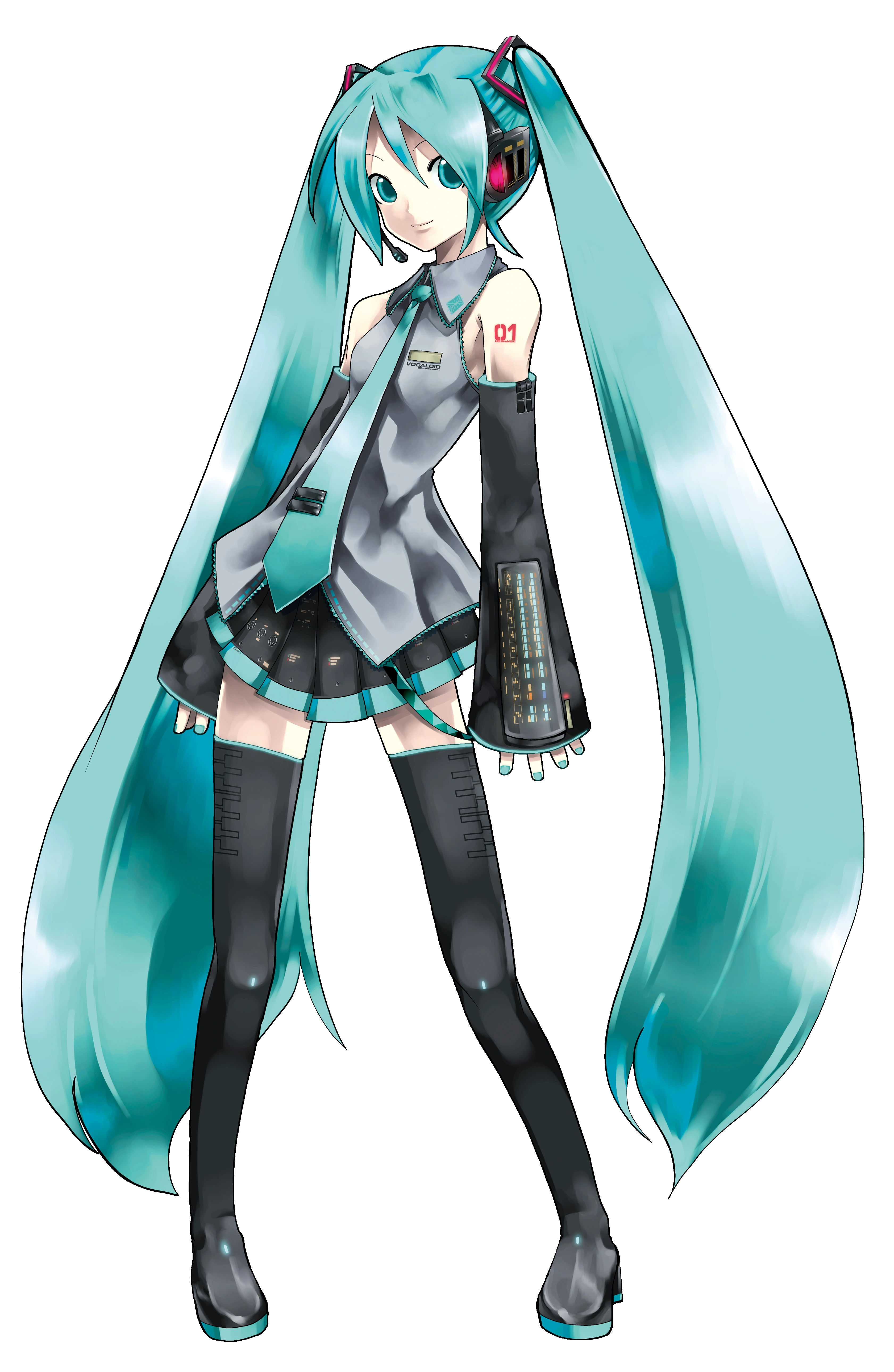Hatsune Miku is a virtual pop idol created by Crypton Future Media, famous for her vibrant appearance and synthesized singing voice. She is part of the Vocaloid software, a program that allows users to generate music using her voice. Visually, Hatsune Miku is instantly recognizable with her long turquoise hair, typically styled in twin-tails that reach well past her knees, giving her a futuristic and anime-inspired look. Her eyes are often depicted in a matching bright turquoise or aqua blue, further enhancing her digital persona.
Her outfit is equally iconic, consisting of a sleeveless gray top with turquoise accents, paired with a short black skirt. She often wears detached sleeves, black thigh-high boots, and a turquoise tie, all of which add to her distinct and modern aesthetic. A black headset with a microphone is a key part of her look, emphasizing her identity as a digital singer.
Personality-wise, Miku does not have a fixed character. This allows fans and creators to interpret her in different ways, often portraying her as cheerful, energetic, and upbeat, although she can take on many different personas depending on the song or artwork she’s featured in. Since she was designed to be a "blank slate," her identity shifts based on the creative input of her fans.
Miku has become a global cultural phenomenon, performing live as a hologram with real musicians in concerts. Her popularity lies not just in her songs but in the fact that fans themselves produce much of her music, making her a collaborative icon in music and digital culture.
Hatsune Miku was created by Crypton Future Media and debuted on August 31, 2007, as part of the Vocaloid 2 software. Her voice was synthesized from samples recorded by voice actress Saki Fujita, allowing users to create songs by inputting their own lyrics and melodies. What set Miku apart was not just the technology but her distinctive character design—an anime-inspired girl with long turquoise twin-tails—which made her highly appealing to fans and musicians alike.
Soon after her release, Miku became a viral sensation in Japan. Fans began creating and sharing songs, videos, and artwork featuring her on platforms like Nico Nico Douga. This user-generated content led to a massive fanbase, helping Hatsune Miku transcend her role as a voice synthesizer and become a cultural icon. In 2009, Crypton began hosting holographic concerts where Miku performed as a 3D projection alongside live musicians, an innovation that made her even more popular.
As her fame spread, Miku gained international recognition, performing at major venues around the world and appearing in collaborations with brands and artists. She has remained relevant with frequent software updates that expand her vocal range, and she continues to represent the future of music, blending technology, creativity, and global fandom.
Hatsune Miku's influence has grown far beyond Vocaloid software. She has appeared in video games, commercials, and even on The Late Show with David Letterman. Her holographic concerts attract thousands, blending music and technology. Collaborations with brands and events like Magical Mirai showcase her lasting global appeal, highlighting the power of fan-driven creativity and the blending of virtual and real-world culture.
Hatsune Miku is a virtual pop star created by Crypton Future Media in 2007, but she has developed a distinct personality and identity shaped by her fans and creators. As a persona, Miku is often portrayed as energetic, optimistic, and cheerful. Her upbeat demeanor resonates with her role as a performer who spreads joy and creativity through her music.
Miku embodies creativity, not just through her own songs but through the thousands of fan-created works she has inspired. She is a collaborative figure, as her voice is synthesized using the Vocaloid software, allowing anyone to compose songs with her voice. This gives her a unique, almost community-driven identity, where her "personality" can shift depending on the context of the music, lyrics, or fan interpretations.
In terms of interests, Miku is associated with futuristic, sci-fi aesthetics, reflecting her digital origins. Her design often incorporates blue-green colors, particularly her iconic twin-tails, which evoke a sense of technological wonder and innovation. Many fans see her as an embodiment of digital culture, blending music, art, and technology seamlessly.
While Miku doesn't have a fixed backstory like a traditional anime character, she is frequently portrayed as loving music, performing, and connecting with her fans. Her virtual concerts are highly interactive, further emphasizing her role as a symbol of creativity, collaboration, and modern digital art. In essence, Hatsune Miku is a flexible, inspiring, and futuristic icon who represents the power of creativity and shared expression in the digital age.
:3
